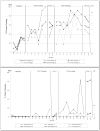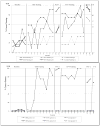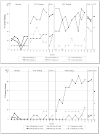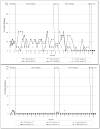Contrasting effects of errorless naming treatment and gestural facilitation for word retrieval in aphasia
- PMID: 22047100
- PMCID: PMC3290698
- DOI: 10.1080/09602011.2011.618306
Contrasting effects of errorless naming treatment and gestural facilitation for word retrieval in aphasia
Abstract
We compared the effects of two treatments for aphasic word retrieval impairments, errorless naming treatment (ENT) and gestural facilitation of naming (GES), within the same individuals, anticipating that the use of gesture would enhance the effect of treatment over errorless treatment alone. In addition to picture naming, we evaluated results for other outcome measures that were largely untested in earlier ENT studies. In a single participant crossover treatment design, we examined the effects of ENT and GES in eight individuals with stroke-induced aphasia and word retrieval impairments (three semantic anomia, five phonological anomia) in counterbalanced phases across participants. We evaluated effects of the two treatments for a daily picture naming/gesture production probe measure and in standardised aphasia tests and communication rating scales administered across phases of the experiment. Both treatments led to improvements in naming of trained words (small-to-large effect sizes) in individuals with semantic and phonological anomia. Small generalised naming improvements were noted for three individuals with phonological anomia. GES improved use of corresponding gestures for trained words (large effect sizes). Results were largely maintained at one month post-treatment completion. Increases in scores on standardised aphasia testing also occurred for both ENT and GES training. Both ENT and GES led to improvements in naming measures, with no clear difference between treatments. Increased use of gestures following GES provided a potential compensatory means of communication for those who did not improve verbal skills. Both treatments are considered to be effective methods to promote recovery of word retrieval and verbal production skills in individuals with aphasia.
Figures










References
-
- Bernardis P, Gentilucci M. Speech and gesture share the same communication system. Neuropsychologia. 2006;44:178–190. - PubMed
-
- Breese EL, Hillis AE. Auditory comprehension: Is multiple choice really good enough? Brain and Language. 2004;89:3–8. - PubMed
-
- Busk PL, Serlin RC. Meta-analysis for single-case research. In: Kratochwill TR, Levin JR, editors. Single-case research design and analysis. Hillsdale, NJ: Erlbaum; 1992. pp. 187–212.
-
- Conroy P, Sage K, Lambon Ralph MA. Errorless and errorful theray for verb and noun naming in aphasia. Aphasiology. 2009;23(11):1311–1337.
Publication types
MeSH terms
Grants and funding
LinkOut - more resources
Full Text Sources
Medical
Research Materials
Miscellaneous
